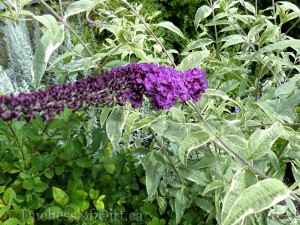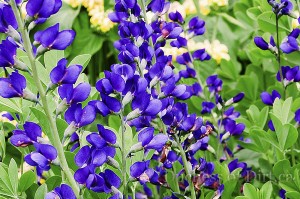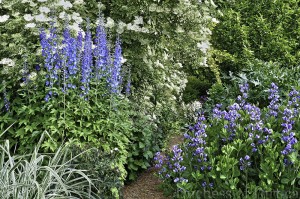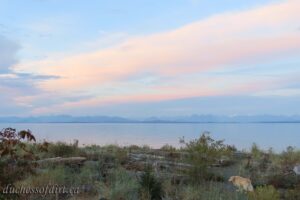Plant IDs updated
by Leslie Cox; Wednesday; September 25, 2024
Two more Plant IDs have been updated in the new format layout. The photographs in both the new Baptisia australis and Buddleja davidii ‘Harlequin’ plant information pages are now accessible and working as they should.
Click on the photos and they will open in a new tab in a larger size for viewing both on this page and their Plant ID pages.
Teaser Tuesday
Buddleja davidii ‘Harlequin’
 Buddleja davidii ‘Harlequin’
Buddleja davidii ‘Harlequin’
(bud-LEE-ah dah-VID-ee-ee)
syn. Buddleia davidii ‘Harlequin’
Family: Scrophulariaceae
Common name: ‘Harlequin’ butterfly bush; summer lilac
Zone: 6 – 9
Height: 5-7 ft (1.5-2.0m)
Spread: 3-5 ft (0.9-1.5m)
Aspect: full sun; partial shade
Soil: average; well-draining
Water: moderate
Description: A deciduous shrub with a bushy, arching branch, vase-shaped growth habit. Lanceolate light green leaves are edged with creamy soft butter-yellow margins in spring that lighten to creamy white in summer. Masses of cylindrical panicles of reddish-purple fragrant flowers appear in early summer through to autumn.
Special Notes: ‘Harlequin’ is a sport of B. d. ‘Royal Red’. Large buddleja should be pruned annually as their branches tend to split with age. Prune shrub back to 2 ft (60 cm) in late winter. Do not prune hard in autumn as this may reduce its winter hardiness. Flowers on current year’s growth. Attracts bees and butterflies. Drought tolerant. Deer reportedly only feed on buddleja as a last resort. Propagation by softwood cuttings in summer.
Posted on April 19, 2013; updated on September 23, 2024
Baptisia australis
 Baptisia australis
Baptisia australis
(bap-TEE-zsah oss-TRAL-iss)
syn. Baptisia caerulea
Family: Papilionaceae
Common name: blue false indigo; blue wild indigo; plains false indigo
Zone: 4 – 9
Height: 3-4 ft (90-120 cm)
Spread: 3 ft (90 cm)
Aspect: full sun; partial shade
Soil: average; well-draining
Water: moderate
 Description: An herbaceous perennial with an upright, arching habit. Attractive blue-green, palmate leaves with inversely lance-shaped leaflets. Deep indigo blue pea-like flowers in racemes on erect spikes appear in June and July. Dark, pea-like seed pods follow in late summer.
Description: An herbaceous perennial with an upright, arching habit. Attractive blue-green, palmate leaves with inversely lance-shaped leaflets. Deep indigo blue pea-like flowers in racemes on erect spikes appear in June and July. Dark, pea-like seed pods follow in late summer.
Special Notes: Native to North America. Plant takes two to three years to establish well and flower. Site well in the garden as this plant is not partial to being moved. May require staking in a windy location. Drought tolerant. Attracts bees and butterflies. Good cut flower. Attractive seed pods are excellent in dried arrangements. May suffer occasional fungal leaf spots, powdery mildew and rust. Propagate by seed; division in spring or autumn.
RHS Award of Garden Merit 1993; Great Plant Pick 2011
In our Zone 7a garden: Patience is a virtue with this plant as it does take the two to three years to establish itself before flowering. But oh, is it ever so worth the wait! As for its purported dislike for being moved once planted…we have not experienced any horrific upset in the Baptisia australis plants we have moved around in our landscape design for one reason or another. Perhaps because we always amend the planting hole with compost or aged manure and add in a very generous helping of our homemade complete fertiliser before planting or transplanting any of our plants.
Posted on September 22, 2012; updated on September 23, 2024
Did you know?
by Leslie Cox; Monday; September 23, 2024
…bluebells (Hyacinthoides non-scripta) were prized for more than their pretty blue flowers?
Centuries ago, their sticky sap was valued as a glue to bind pages in books. And for almost as long as bows and arrows were the weapon of choice, the sap was used to attach feathers to the arrows.
 During the reign of Queen Elizabeth I, (1558 – 1603), the servants in charge of looking after all the royal and high society’s finery used crushed bluebell bulbs to make starch for stiffening the high ruffs on coat and dress collars and the ruffs at the end of the sleeves.
During the reign of Queen Elizabeth I, (1558 – 1603), the servants in charge of looking after all the royal and high society’s finery used crushed bluebell bulbs to make starch for stiffening the high ruffs on coat and dress collars and the ruffs at the end of the sleeves.
Nowadays starch is made from tapioca, potatoes, corn and wheat.


